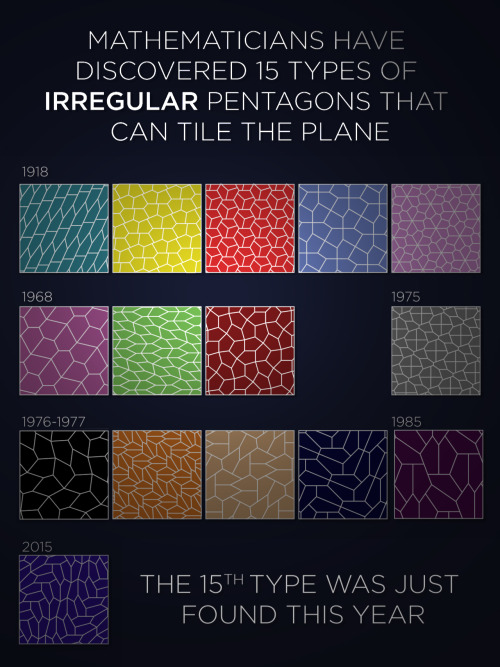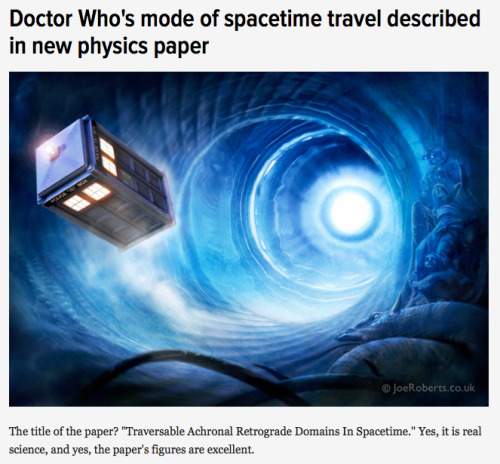Big Math News! It’s Been Thirty Years Since Mathematicians Last Found A Convex Pentagon That Could








Big math news! It’s been thirty years since mathematicians last found a convex pentagon that could “tile the plane.” The latest discovery (by Jennifer McLoud-Mann, Casey Mann, and David Von Derau) was published earlier this month. Full story.
More Posts from Jupyterjones and Others
When 25,000 little dice are agitated in a cylinder, they form into neat concentric circles

Behold the magic of compaction dynamics. Scientists from Mexico and Spain dumped 25,000 tiny dice (0.2 inches) into a large clear plastic cylinder and rotated the cylinder back and forth once a second. The dice arranged themselves into rows of concentric circles. See the paper and the videos here.
https://boingboing.net/2017/12/05/when-25000-little-dice-are-ag.html

That’s the secret of programming.
New Research Heading to Earth’s Orbiting Laboratory
It’s a bird! It’s a plane! It’s a…dragon? A SpaceX Dragon spacecraft is set to launch into orbit atop the Falcon 9 rocket toward the International Space Station for its 12th commercial resupply (CRS-12) mission August 14 from our Kennedy Space Center in Florida.

It won’t breathe fire, but it will carry science that studies cosmic rays, protein crystal growth, bioengineered lung tissue.

Here are some highlights of research that will be delivered:
I scream, you scream, we all scream for ISS-CREAM!
Cosmic Rays, Energetics and Mass, that is! Cosmic rays reach Earth from far outside the solar system with energies well beyond what man-made accelerators can achieve. The Cosmic Ray Energetics and Mass (ISS-CREAM) instrument measures the charges of cosmic rays ranging from hydrogen to iron nuclei. Cosmic rays are pieces of atoms that move through space at nearly the speed of light

The data collected from the instrument will help address fundamental science questions such as:
Do supernovae supply the bulk of cosmic rays?
What is the history of cosmic rays in the galaxy?
Can the energy spectra of cosmic rays result from a single mechanism?
ISS-CREAM’s three-year mission will help the scientific community to build a stronger understanding of the fundamental structure of the universe.
Space-grown crystals aid in understanding of Parkinson’s disease
The microgravity environment of the space station allows protein crystals to grow larger and in more perfect shapes than earth-grown crystals, allowing them to be better analyzed on Earth.

Developed by the Michael J. Fox Foundation, Anatrace and Com-Pac International, the Crystallization of Leucine-rich repeat kinase 2 (LRRK2) under Microgravity Conditions (CASIS PCG 7) investigation will utilize the orbiting laboratory’s microgravity environment to grow larger versions of this important protein, implicated in Parkinson’s disease.

Defining the exact shape and morphology of LRRK2 would help scientists to better understand the pathology of Parkinson’s and could aid in the development of therapies against this target.
Mice Help Us Keep an Eye on Long-term Health Impacts of Spaceflight
Our eyes have a whole network of blood vessels, like the ones in the image below, in the retina—the back part of the eye that transforms light into information for your brain. We are sending mice to the space station (RR-9) to study how the fluids that move through these vessels shift their flow in microgravity, which can lead to impaired vision in astronauts.

By looking at how spaceflight affects not only the eyes, but other parts of the body such as joints, like hips and knees, in mice over a short period of time, we can develop countermeasures to protect astronauts over longer periods of space exploration, and help humans with visual impairments or arthritis on Earth.
Telescope-hosting nanosatellite tests new concept
The Kestrel Eye (NanoRacks-KE IIM) investigation is a microsatellite carrying an optical imaging system payload, including an off-the-shelf telescope. This investigation validates the concept of using microsatellites in low-Earth orbit to support critical operations, such as providing lower-cost Earth imagery in time-sensitive situations, such as tracking severe weather and detecting natural disasters.

Sponsored by the ISS National Laboratory, the overall mission goal for this investigation is to demonstrate that small satellites are viable platforms for providing critical path support to operations and hosting advanced payloads.
Growth of lung tissue in space could provide information about diseases
The Effect of Microgravity on Stem Cell Mediated Recellularization (Lung Tissue) uses the microgravity environment of space to test strategies for growing new lung tissue. The cells are grown in a specialized framework that supplies them with critical growth factors so that scientists can observe how gravity affects growth and specialization as cells become new lung tissue.

The goal of this investigation is to produce bioengineered human lung tissue that can be used as a predictive model of human responses allowing for the study of lung development, lung physiology or disease pathology.
These crazy-cool investigations and others launching aboard the next SpaceX #Dragon cargo spacecraft on August 14. They will join many other investigations currently happening aboard the space station. Follow @ISS_Research on Twitter for more information about the science happening on 250 miles above Earth on the space station.
Watch the launch live HERE starting at 12:20 p.m. EDT on Monday, Aug. 14!
Make sure to follow us on Tumblr for your regular dose of space: http://nasa.tumblr.com

Co-authored by physicists Ben Tippett* and David Tsang (non-fictional physicists at the fictional Gallifrey Polytechnic Institute and Gallifrey Institute of Technology, respectively), the paper – which you can access free of charge over on arXiv – presents a spacetime geometry that would make retrograde time travel possible. Such a spacetime geometry, write the researchers, would emulate “what a layperson would describe as a time machine“ [x]

Calculating the surface area of a sphere. Found on Imgur.

This shows that the probability of a random variable is maximum at the average and diminishes as one goes away from it, eventually leading to a bell-curve.
How Do Hurricanes Form?
Hurricanes are the most violent storms on Earth. People call these storms by other names, such as typhoons or cyclones, depending on where they occur.

The scientific term for ALL of these storms is tropical cyclone. Only tropical cyclones that form over the Atlantic Ocean or eastern and central Pacific Ocean are called “hurricanes.”

Whatever they are called, tropical cyclones all form the same way.
Tropical cyclones are like giant engines that use warm, moist air as fuel. That is why they form only over warm ocean waters near the equator. This warm, moist air rises and condenses to form clouds and storms.

As this warmer, moister air rises, there’s less air left near the Earth’s surface. Essentially, as this warm air rises, this causes an area of lower air pressure below.

This starts the ‘engine’ of the storm. To fill in the low pressure area, air from surrounding areas with higher air pressure pushes in. That “new” air near the Earth’s surface also gets heated by the warm ocean water so it also gets warmer and moister and then it rises.

As the warm air continues to rise, the surrounding air swirls in to take its place. The whole system of clouds and wind spins and grows, fed by the ocean’s heat and water evaporating from the surface.
As the storm system rotates faster and faster, an eye forms in the center. It is vey calm and clear in the eye, with very low air pressure.

Tropical cyclones usually weaken when they hit land, because they are no longer being “fed” by the energy from the warm ocean waters. However, when they move inland, they can drop many inches of rain causing flooding as well as wind damage before they die out completely.
There are five types, or categories, of hurricanes. The scale of categories is called the Saffir-Simpson Hurricane Scale and they are based on wind speed.

How Does NASA Study Hurricanes?
Our satellites gather information from space that are made into pictures. Some satellite instruments measure cloud and ocean temperatures. Others measure the height of clouds and how fast rain is falling. Still others measure the speed and direction of winds.

We also fly airplanes into and above hurricanes. The instruments aboard planes gather details about the storm. Some parts are too dangerous for people to fly into. To study these parts, we use airplanes that operate without people.
Learn more about this and other questions by exploring NASA Space Place and the NASA/NOAA SciJinks that offer explanations of science topics for school kids.
Make sure to follow us on Tumblr for your regular dose of space: http://nasa.tumblr.com.
Credits: NASA Space Place & NASA/NOAA SciJinks






The 21 Card Trick created in Python.
See how it works and read a little more about it here: [x]
Feel free to ask any questions you may have. :)
-
 andrewducker reblogged this · 1 month ago
andrewducker reblogged this · 1 month ago -
 anonymous-ivplay reblogged this · 1 month ago
anonymous-ivplay reblogged this · 1 month ago -
 herehaveafandom reblogged this · 1 month ago
herehaveafandom reblogged this · 1 month ago -
 kail-lizuc reblogged this · 2 months ago
kail-lizuc reblogged this · 2 months ago -
 kail-lizuc liked this · 2 months ago
kail-lizuc liked this · 2 months ago -
 jazzymothcryptid liked this · 2 months ago
jazzymothcryptid liked this · 2 months ago -
 thatsjustnotit reblogged this · 2 months ago
thatsjustnotit reblogged this · 2 months ago -
 dahliavandare reblogged this · 2 months ago
dahliavandare reblogged this · 2 months ago -
 socraticcryptid reblogged this · 2 months ago
socraticcryptid reblogged this · 2 months ago -
 deathsmallcaps reblogged this · 2 months ago
deathsmallcaps reblogged this · 2 months ago -
 vaivala reblogged this · 3 months ago
vaivala reblogged this · 3 months ago -
 numbersoftoday liked this · 3 months ago
numbersoftoday liked this · 3 months ago -
 cosmic-navel-gazin liked this · 4 months ago
cosmic-navel-gazin liked this · 4 months ago -
 phgmath reblogged this · 4 months ago
phgmath reblogged this · 4 months ago -
 phgmath liked this · 4 months ago
phgmath liked this · 4 months ago -
 imsquat reblogged this · 4 months ago
imsquat reblogged this · 4 months ago -
 imsquat liked this · 4 months ago
imsquat liked this · 4 months ago -
 scentedlovebeliever reblogged this · 5 months ago
scentedlovebeliever reblogged this · 5 months ago -
 scentedlovebeliever liked this · 5 months ago
scentedlovebeliever liked this · 5 months ago -
 nulla-dies-sine-rosa reblogged this · 6 months ago
nulla-dies-sine-rosa reblogged this · 6 months ago -
 awfuckward liked this · 6 months ago
awfuckward liked this · 6 months ago -
 wormdudes reblogged this · 6 months ago
wormdudes reblogged this · 6 months ago -
 nixetra liked this · 6 months ago
nixetra liked this · 6 months ago -
 subjectaash-maxx liked this · 7 months ago
subjectaash-maxx liked this · 7 months ago -
 foe-paw reblogged this · 7 months ago
foe-paw reblogged this · 7 months ago -
 kassandra-wasp-hyena-girlthigh reblogged this · 7 months ago
kassandra-wasp-hyena-girlthigh reblogged this · 7 months ago -
 whositsandwhatits reblogged this · 7 months ago
whositsandwhatits reblogged this · 7 months ago -
 admiral-hast reblogged this · 7 months ago
admiral-hast reblogged this · 7 months ago -
 mintbecrazy liked this · 7 months ago
mintbecrazy liked this · 7 months ago -
 that-weird-bee reblogged this · 7 months ago
that-weird-bee reblogged this · 7 months ago -
 watercraver liked this · 7 months ago
watercraver liked this · 7 months ago -
 watercraver reblogged this · 7 months ago
watercraver reblogged this · 7 months ago -
 panictree liked this · 7 months ago
panictree liked this · 7 months ago -
 a-strange-grey reblogged this · 7 months ago
a-strange-grey reblogged this · 7 months ago -
 znarikia reblogged this · 7 months ago
znarikia reblogged this · 7 months ago -
 znarikia liked this · 7 months ago
znarikia liked this · 7 months ago -
 frandomly-trash liked this · 7 months ago
frandomly-trash liked this · 7 months ago -
 matrim-cauthons-hat reblogged this · 7 months ago
matrim-cauthons-hat reblogged this · 7 months ago -
 matrim-cauthons-hat liked this · 7 months ago
matrim-cauthons-hat liked this · 7 months ago -
 itmewyrm liked this · 7 months ago
itmewyrm liked this · 7 months ago -
 heckie-dot-net reblogged this · 7 months ago
heckie-dot-net reblogged this · 7 months ago -
 ranked-competitive-sexhaver liked this · 7 months ago
ranked-competitive-sexhaver liked this · 7 months ago -
 briarplant reblogged this · 7 months ago
briarplant reblogged this · 7 months ago -
 theaprilofnoa reblogged this · 7 months ago
theaprilofnoa reblogged this · 7 months ago -
 shosela liked this · 7 months ago
shosela liked this · 7 months ago -
 fishlung8877 liked this · 7 months ago
fishlung8877 liked this · 7 months ago -
 cyborg-hydra-girl-thing reblogged this · 7 months ago
cyborg-hydra-girl-thing reblogged this · 7 months ago -
 lateleviathan liked this · 7 months ago
lateleviathan liked this · 7 months ago -
 thelaithlyworm liked this · 7 months ago
thelaithlyworm liked this · 7 months ago


